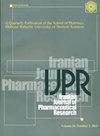氧化锌纳米颗粒与乳酸杆菌上清液对 ESKAPE 细菌的抗菌活性和毒性:一种新型混合物
IF 1.8
4区 医学
Q3 PHARMACOLOGY & PHARMACY
引用次数: 0
摘要
背景:院内病原菌多药耐药的出现促使研究人员寻找新的抗菌药物来源。金属纳米颗粒和益生菌产品引起了研究人员的关注。然而,在这个领域,联合治疗是一个有吸引力的选择。目的:研究氧化锌纳米颗粒(ZnO-NPs)与植物乳杆菌(L. plantarum)和嗜酸乳杆菌(L. acidophilus)的无细胞上清(CFS)单独和新型混合物的抗菌活性和毒性。方法:测定ZnO-NPs、植物乳杆菌CFS (SLP)和嗜酸乳杆菌CFS (SLA)单独和混合对ESKAPE菌株的抑菌作用和细胞毒性。此外,对暴露于这些试剂后的细胞存活率进行了评估。结果:ZnO-NPs与SLP或ZnO-NPs与SLA的抗菌组合对铜绿假单胞菌(FIC≤0.75)、鲍曼不动杆菌(FIC = 1)和大肠杆菌(FIC≤0.75)具有协同和加性作用。在相同浓度下,ZnO-NPs和SLA混合作用24 h后,细胞存活率(约50%)高于单独作用ZnO-NPs时(约30%)。结论:ZnO-NPs和CFS混合益生菌可作为抗生素的替代方案,具有更高的疗效和更小的副作用。本文章由计算机程序翻译,如有差异,请以英文原文为准。
Antibacterial Activity and Toxicity of Zinc Oxide Nanoparticles Combined with Supernatants of Lactobacillus spp. Against ESKAPE Bacteria: A Novel Mixture
Background: The emergence of multidrug resistance among nosocomial pathogens has prompted researchers to look for new antibacterial sources. Metal nanoparticles and probiotic products have attracted the attention of researchers. However, combination therapy is an attractive alternative in this field. Objectives: This study evaluated the antibacterial activity and toxicity of Zinc Oxide nanoparticles (ZnO-NPs) combined with Cell-free Supernatant (CFS) of Lactobacillus plantarum (L. plantarum) and Lactobacillus acidophilus (L. acidophilus) alone and in a novel mixture. Methods: Antibacterial effects and cytotoxic properties of ZnO-NPs, CFS of L. plantarum (SLP), and CFS of L. acidophilus (SLA) were determined alone and in a mixture against ESKAPE strains. In addition, the viability percentage of the cells was evaluated after exposure to these agents. Results: Antibacterial mixtures (ZnO-NPs with SLP or ZnO-NPs with SLA) demonstrated synergistic and additive effects against Pseudomonas aeruginosa (FIC≤0.75), Acinetobacter baumannii (FIC = 1), and Escherichia coli (FIC≤0.75). The viability percentage of the cells after 24 h of exposure to a mixture of ZnO-NPs and SLA (about 50%) was more than when the cells were exposed to ZnO-NPs alone (about 30%) at the same concentration. Conclusions: A mixture of ZnO-NPs and CFS of probiotics can be an alternative to antibiotics, with more effectiveness and fewer side effects.
求助全文
通过发布文献求助,成功后即可免费获取论文全文。
去求助
来源期刊
CiteScore
3.40
自引率
6.20%
发文量
52
审稿时长
2 months
期刊介绍:
The Iranian Journal of Pharmaceutical Research (IJPR) is a peer-reviewed multi-disciplinary pharmaceutical publication, scheduled to appear quarterly and serve as a means for scientific information exchange in the international pharmaceutical forum. Specific scientific topics of interest to the journal include, but are not limited to: pharmaceutics, industrial pharmacy, pharmacognosy, toxicology, medicinal chemistry, novel analytical methods for drug characterization, computational and modeling approaches to drug design, bio-medical experience, clinical investigation, rational drug prescribing, pharmacoeconomics, biotechnology, nanotechnology, biopharmaceutics and physical pharmacy.

 求助内容:
求助内容: 应助结果提醒方式:
应助结果提醒方式:


